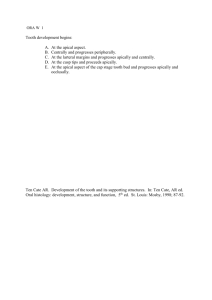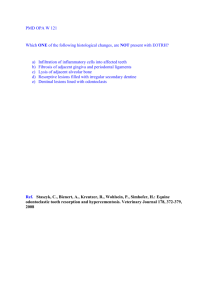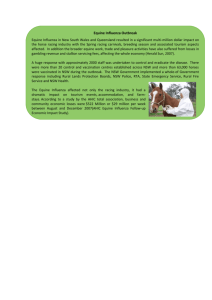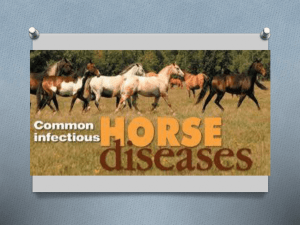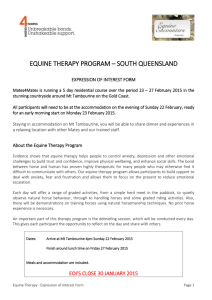Released EVDC Eq Exam Example Questions Oral Medicine 7
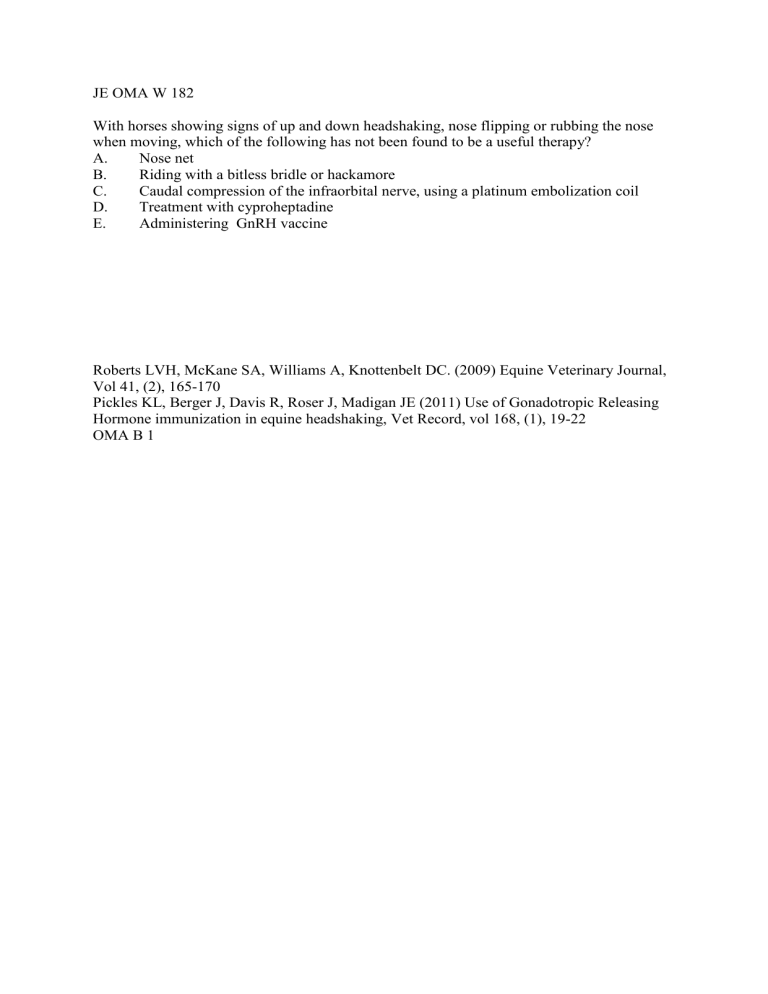
JE OMA W 182
With horses showing signs of up and down headshaking, nose flipping or rubbing the nose when moving, which of the following has not been found to be a useful therapy?
A. Nose net
B. Riding with a bitless bridle or hackamore
C. Caudal compression of the infraorbital nerve, using a platinum embolization coil
D. Treatment with cyproheptadine
E. Administering GnRH vaccine
Roberts LVH, McKane SA, Williams A, Knottenbelt DC. (2009) Equine Veterinary Journal,
Vol 41, (2), 165-170
Pickles KL, Berger J, Davis R, Roser J, Madigan JE (2011) Use of Gonadotropic Releasing
Hormone immunization in equine headshaking, Vet Record, vol 168, (1), 19-22
OMA B 1
Which horse breed most commonly shares the skull morphology depicted in the image?
A.
American Quarter Horse
B.
Morgan Horse
C.
Irish Warmblood
D.
Thoroughbred
E.
Arabian
Dixon PM, duToit N, Dental Anatomy, In. Easley, Dixon, Schumacher ed., Equine Dentistry,
3rd ed,Saunders/Elsevier, 2010, 70
OMA B 2
Which of the following best describes the bridling system in the picture? a) Loose ring snaffle and flash nose band b) Full cheek snaffle and drop nose band c) Ring draw reins and flash nose band d) Bosal hackamore with curb strap e) D-ring snaffle with curb strap
Bennett DG, Bits, bridles and accessories. In. Easley, Dixon, Schumacher ed., Equine
Dentistry, 3rd ed, Saunders/Elsevier, 2010, 27-42
JE OMB W 193
A ten year old grey Arab gelding that had been managed the previous year for metabolic disease developed bilateral symmetrical enlargements of the facial bones and horizontal rami of the mandibles. Radiographs revealed loss of bone density and radiolucency of the facial bones and mandible. What condition would be highest on your list of differential diagnosis?
A. Nutritional secondary hyperparathyroidism
B. Ossifying Fibroma
C. Malignant melanoma
D. Hyperthyroidism
E. Nutritional secondary osteoporosis
Schumacher J, Dixon PM, (2007), Diseases of the Nasal Cavities, In Equine Respiratory
Medicine and Surgery ed. McGorum BC, Dixon PM, Robinson NE, Schumacher J,
Saunders/Elseiver, Edinburgh, 389
OMB B 1
Which of the following diagnoses is most likely regarding the images provided?
A.
juvenile ossifying fibroma
B.
complex odontoma
C.
rostral mandibular osteoma
D.
osteosarcoma
E.
metastatic osteodystrophy fibrosa
Madron MS, McClure SR, Yaeger, Fibro-osseous tumor of the second metacarpal bone in a
Thoroughbred filly, Equine Veterinary Edu/AE/, 2013, 231-240
Knottenbelt DC, Kelly DF, Oral and Dental Tumors, in Easley, Dixon Schumacher ed.
Equine Dentistry , 3 rd ed, Saunders/Elsevier, 2010, 173-174
OMC B 1
This is an extracted upper cheek tooth (210) from a 6-year-old horse that presented with a left sided nasal discharge and chronic sinusitis of dental origin. According to the image and the article by Dacre I, Kempson SA, Dixon PM. ‘Pathological studies of cheek teeth apical infections in the horse. Part 5: Aetiopathological findings in 57 apically infected maxillary cheek teeth and histological and ultrastructural findings’ ( The Vet J 2008; 178: 352-363), what is the most likely etiopathology of this apical infection?
A.
Infundibular caries
B.
Anachorectic infection
C.
Periodontal infection
D.
Fissure of the cheek tooth
E.
Dysplastic tooth
(Reference above)
NDT OMC W 202
A 350 kg 24-year-old retired pony with a normal body condition score, has severe smooth mouth on oral examination with no effective masticatory occlusal surface. Based on the daily digestible energy requirement for horses, which of the following diets would be an acceptable diet to satisfy the nutritional requirements of the pony taking the dental disease into account:
A.
6 kg of long stemmed Timothy hay
B.
3.5 kg of long stemmed alfalfa hay with 1.5 kg complete senior forage pellets
C.
5.25 kg of long stemmed Timothy hay with 1 kg soaked beet pulp
D.
5 kg of a complete senior forage pelleted diet
E.
1.5 kg of long stemmed alfalfa hay with 3 kg soaked beet pulp
Andrew JE, Kline KH, Smith JL. Effects if feed form on growth and blood glucose in weanling horses. J Equine Vet Sci 2006; 26: 349-355.
Geor RJ, Aspects of Clinical Nutrition. In: Reed SM, Bayly WM, Sellon DC eds. Equine Internal
Medicine 3 rd ed. 2010, Elsevier Saunders, St Louis, 205 – 232


